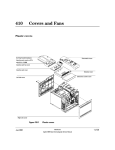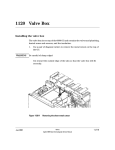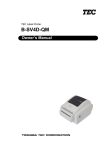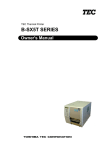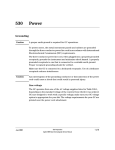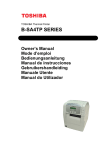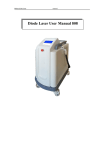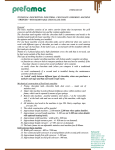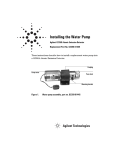Download Installation Guide - Agilent Technologies
Transcript
Installation Guide Flame Ionization Detector on a 6850 GC Accessory G2621 © Agilent Technologies 2000 Safety Information Safety Symbols All Rights Reserved. Reproduction, adaptation, or translation without permission is prohibited, except as allowed under the copyright laws. The Agilent Technologies Flame Ionization Detector meets the following IEC (International Electrotechnical Commission) classifications: Safety Class 1, Transient Overvoltage Category II, and Pollution Degree 2. Warnings in the manual or on the instrument must be observed during all phases of operation, service, and repair of this instrument. Failure to comply with these precautions violates safety standards of design and the intended use of the instrument. Agilent Technologies assumes no liability for the customer’s failure to comply with these requirements. Part number G2621-90107 First Edition, DEC 2000 Replaces Part No. G2621-90100 Operating and Service Manual. HP® is a registered trademark of Hewlett-Packard Co. Printed in USA This unit has been designed and tested in accordance with recognized safety standards and designed for use indoors. If the instrument is used in a manner not specified by the manufacturer, the protection provided by the instrument may be impaired. Whenever the safety protection of the Agilent G2621 has been compromised, disconnect the unit from all power sources and secure the unit against unintended operation. Refer servicing to qualified service personnel. Substituting parts or performing any unauthorized modification to the instrument may result in a safety hazard. Disconnect the AC power cord before removing covers. The customer should not attempt to replace the battery or fuses in this instrument. WARNING A warning calls attention to a condition or possible situation that could cause injury to the user. CAUTION A caution calls attention to a condition or possible situation that could damage or destroy the product or the user’s work. Sound Emission Certification for Federal Republic of Germany Sound pressure Lp < 68 dB(A) During normal operation At the operator position According to ISO 7779 (Type Test) Schallemission Schalldruckpegel LP < 68 dB(A) Am Arbeitsplatz Normaler Betrieb Nach DIN 45635 T. 19 (Typprüfung) Agilent Technologies, Inc. 2850 Centerville Road Wilmington, DE 19808-1610 USA Installing a Flame Ionization Detector on an Agilent 6850 Gas Chromatograph This kit contains: Kit G2621-64000 Qty. Flame ionization detector system 1 Performance evaluation sample kit 1 Nut warmer cup assembly 1 Nut warmer insulation 1 Wrist strap, disposable, large 1 Screw, M4 x12 mm, pan head 3 Installation sheet (this document) 1 Copyright© 2000 Agilent Technologies Printed in USA Dec 2000 Agilent Part No. G2621-90107 1 Installing a Flame Ionization Detector on an Agilent 6850 Gas Chromatograph The FID detector assembly is a factory-assembled, tested, and calibrated unit. Disassembly of the unit is not required for installation. Ribbon cable Heater/sensor cable FID assembly Ignitor cable Nutwarmer Flow module cable Insulation (3 pieces) Screws Flow module FID signal board Tools Required Torx™ T-20 driver Flat blade screwdriver Open end wrenches Safety Information Before continuing, read the safety information on your Agilent 6850 Gas Chromatograph User Information CD-ROM. 2 Installing a Flame Ionization Detector on an Agilent 6850 Gas Chromatograph Prepare for Installation WARNING Hydrogen gas is flammable and potentially explosive. Before replacing the manifold, turn off the hydrogen gas at the source. WARNING Before proceeding, turn off the oven and any heated zones and let them cool down. Turn off all detector gases at their supply, then turn off the main power switch and unplug the power cord. 1. Open the lid. If a column is installed, disconnect it at the detector end. Remove the nut warmer, insulation, and capillary adapter, if present. Close the lid. 2. Turn all gases off at their sources. Disconnect the carrier and detector gas tubing from the back panel of the instrument. Disconnect gas supply tubing from these fittings BNC BNC To Base - T To Base - T Local Talk Local Talk 3 Installing a Flame Ionization Detector on an Agilent 6850 Gas Chromatograph Remove the Lid Top Cover Remove vent tubing, if present Lid top cover, without valve box accessory Remove T-20 Torx™ screws (8 places) Remove detector cover, if desired Remove the lid top cover. Disconnect the Heater/Sensor Cable 1. Trace the detector heater/sensor cable to the wiring harness near the injection part cooling fan. 2. Disconnect the cable at the connector. Raise the Lid to the Service Position 1. 4 Open the lid. Locate the counterbalance cam in the left rear corner under the lid. Loosen the screw on the right side of the cam. This allows the stop plate to drop down. Installing a Flame Ionization Detector on an Agilent 6850 Gas Chromatograph Cam follower Stop plate Screw Counterbalance cam WARNING 2. Raise the lid until it is stopped by the safety cable. 3. Raise the stop plate and tighten the screw to lock the lid in the upright service position. The lid is heavy. Always lock the lid when it is in the service position. 5 Installing a Flame Ionization Detector on an Agilent 6850 Gas Chromatograph Remove the Detector Electronics Cover 1. Loosen the two bottom screws on the detector electronics cover. Remove screw Detector electronics cover Loosen screws 6 2. Remove the top screw on the cover. 3. Lift and remove the detector electronics cover. Installing a Flame Ionization Detector on an Agilent 6850 Gas Chromatograph 4. Loosen the signal board clamp. Ribbon cable Signal board (FID shown) Signal board clamp A/D converter board 5. Unplug the signal board from the A/D converter board. 6. Disconnect the wiring from the signal board. FID – Disconnect the ribbon cable. Unplug the ignitor cable. Pass both cables through the hole to the top side of the lid. The ribbon cable connector will not pass through the rubber grommet in the hole. Use a small screwdriver to push the grommet to the top of the lid; the cables will now fit through the hole. 7 Installing a Flame Ionization Detector on an Agilent 6850 Gas Chromatograph Ribbon cable connector Ignitor cable connector TCD – Unplug the two-wire switching valve cable at the connector. To release the PRT and filament wires, press down on the orange tabs. Pass the disconnected wires through the hole to the top side of the lid. Switching valve cable connector PRT wires Filament wires 8 7. Lower the stop plate on the lid cam. Pull the lid forward until the cam follower rests on the curved surface of the cam. Leave the stop plate in the "down" position. 8. Close the lid. Installing a Flame Ionization Detector on an Agilent 6850 Gas Chromatograph Remove the Existing Detector and Flow Manifold 1. On the top of the lid, loosen the connector cover plate screws and remove the plates. Cover plate screws (4) Gas manifold (FID shown) Manifold mounting screws Gas fittings 2. Disconnect the gas fittings. The figure shows the FID manifold; the TCD manifold is similar but has only one gas connection. 3. Trace the ribbon cable from the flow manifold and disconnect it from the harness. 4. Remove the three manifold mounting screws. 5. Remove the screws holding the detector assembly in place. 9 Installing a Flame Ionization Detector on an Agilent 6850 Gas Chromatograph FID – Remove four mounting screws. Mounting screws (one concealed) TCD – Remove two mounting screws. Mounting screws 6. WARNING The fibrous insulation material can cause irritation to the skin, eyes, and mucous membranes. Always wear gloves when working with the insulation. If the insulation is flaky/crumbly, wear protective eyewear and respirator. 7. 10 Lift the detector and flow manifold out of the lid as a unit. Remove any insulation that may be in the hole under the detector. Installing a Flame Ionization Detector on an Agilent 6850 Gas Chromatograph Install the Flame Ionization Detector and Flow Manifold 1. Place the flame ionization detector and flow manifold in position in the lid. Check that no wiring or tubing is trapped under either assembly. Ignitor cable Heater/sensor cable connection Screws (4 places, one not visible) 2. Secure the detector assembly to the lid with four screws. 3. Secure the manifold to the lid with three screws. 4. Plug the manifold ribbon cable into its connector. 5. Install the two connector cover plates. 6. Connect the gas supply lines as shown below. If the previous detector was a TCD, the A and H lines should be folded up in the space under the fittings. Unfold them, being careful to avoid kinks, and feed them up to the manifold area. Connect the line marked A here Connect the line marked M here Connect the line marked H here 11 Installing a Flame Ionization Detector on an Agilent 6850 Gas Chromatograph Connect the Heater/Sensor Cable Connect the detector heater/sensor cable to the wiring harness near the injection part cooling fan. Connect the other Leads and the Signal Board 1. Raise the lid to the service position and lock it in place by raising the stop plate. 2. There is an oblong hole through the lid near the left rear corner of the FID assembly. If there is a grommet in the hole, remove it. Pass the ignitor cable and the ribbon cable through the hole into the signal board space. 3. Use a small screwdriver to install the grommet around the cables in the oblong hole. 4. Connect the ribbon and ignitor cables to the signal board. Ribbon cable connector A/D converter board connector 12 Ignitor connector 5. Turn the signal board over, plug it into the A/D converter board, and secure it with the signal board clamp. 6. Install the detector electronics cover and tighten all three screws. 7. Lower the stop plate on the lid cam. Pull the lid forward until the cam follower rests on the curved surface of the cam. Raise the stop plate behind the cam follower and tighten the screw. 8. Close the lid. Be sure that the folded gas lines do not interfere with it. Installing a Flame Ionization Detector on an Agilent 6850 Gas Chromatograph 9. Install the lid top cover. Finishing Up 1. Install the capillary adapter, if used. 2. Restore the column connection. 3. Restore carrier and other gases to the instrument. 4. Restore power. 5. Apply your normal operating pressures. Leak-check the manifold, back panel, and column fittings. 13 14 Printed on recycled paper. This product is recyclable. Agilent Technologies, Inc. Printed in USA Dec 2000 G2621-90107


















